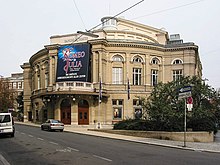Raimund Theater
 |
|
| Address |
Vienna Austria |
|---|---|
| Coordinates | 48°11′32″N 16°20′23″E / 48.19222°N 16.33972°ECoordinates: 48°11′32″N 16°20′23″E / 48.19222°N 16.33972°E |
| Owner | Vereinigte Bühnen Wien |
| Opened | 28 November 1893 |
| Website | |
| www |
|
The Raimund Theater is a theatre in the Mariahilf district of Vienna, Austria.
Named after the Austrian dramatist Ferdinand Raimund, the theatre was built by an association of Viennese citizens and opened on 28 November 1893 with Raimund's play Die gefesselte Phantasie.
The theater is currently owned by Vereinigte Bühnen Wien (VBW) along with the Theater an der Wien and the Ronacher. Its current main use is for major musical productions and can seat around 1,000 persons.
The theater is named after the Austrian dramatist Ferdinand Raimund, it was built by an association of 500 residents of the municipality of Mariahilf. It is designed by Franz Roth and opened on 28 November 1893, fully lit by electricity. Raimund's play Die gefesselte Phantasie opened at the theater (Though its first performance was on 27 November 1893). The theatre mainly presented German folk dramas and plays.
In 1908 it turned to operetta, with Johann Strauss' The Gypsy Baron. Other premieres included Robert Stolz's Das Glücksmädel and Dreimäderlhaus, set to various pieces of music by Franz Schubert; this was performed more than 1200 times between 1916 and 1927.
As the theatre was spared bombing damage during World War II, the theatre re-opened promptly on 25 April 1945 with Dreimäderlhaus. In 1948, Rudolf Marik took over as director for almost 30 years, transforming it into an internationally recognised theatre of the German-speaking world exclusively staging operettas with stars such as Johannes Heesters, Marika Rökk, and others. Many well-known actors started their careers at the Raimund Theatre, including Hansi Niese, Paula Wessely, Attila Hörbiger, and Karl Skraup. After 1976 the theatre was occasionally used for musicals, such as Kurt Weill's Lady in the Dark.
...
Wikipedia
